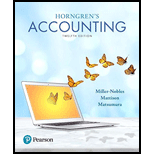
Horngren's Accounting Plus Mylab Accounting With Pearson Etext -- Access Card Package (12th Edition)
12th Edition
ISBN: 9780134674681
Author: Tracie L. Miller-Nobles, Brenda L. Mattison, Ella Mae Matsumura
Publisher: PEARSON
expand_more
expand_more
format_list_bulleted
Question
Chapter 26, Problem P26.29APGA
To determine
Time value of money:
The time value of money concept is based on the theory that differentiates the present value and future value of the money. It simply says that the value of money today shall not be same as the value of same money tomorrow.
1. Money required at the time of retirement
To determine: The amount of money to be accumulated by the retirement
To determine
2. Comparison of present value of annuity and actual annuity amount:
To indicate: The comparison of present value of annuity and actual annuity amount
Expert Solution & Answer
Want to see the full answer?
Check out a sample textbook solution
Students have asked these similar questions
Quiksilver Company sold 4,480 units in October at a price of $63 per unit. The variable cost is $51 per unit. Calculate the total contribution margin. A. $62,060 B. $73,080 C. $56,000 D. $99,750 E. $ 53,760 help
I want to this question answer for General accounting question not need ai solution
Taylor Manufacturing had the following results of operations for the past year:
Chapter 26 Solutions
Horngren's Accounting Plus Mylab Accounting With Pearson Etext -- Access Card Package (12th Edition)
Ch. 26 - Prob. 1QCCh. 26 - Prob. 2QCCh. 26 - Prob. 3QCCh. 26 - Prob. 4QCCh. 26 - Prob. 5QCCh. 26 - Prob. 6QCCh. 26 - Prob. 7QCCh. 26 - The IRR is Learning Objective 4 the interest rate...Ch. 26 - Prob. 9QCCh. 26 - Ian Corp, is considering two expansion projects....
Ch. 26 - Prob. 1RQCh. 26 - Describe the capital budgeting process.Ch. 26 - Prob. 3RQCh. 26 - Prob. 4RQCh. 26 - Prob. 5RQCh. 26 - Prob. 6RQCh. 26 - What is the payback method of analyzing capital...Ch. 26 - Prob. 8RQCh. 26 - Prob. 9RQCh. 26 - What is the decision rule for payback?Ch. 26 - Prob. 11RQCh. 26 - What is the accounting rate of return?Ch. 26 - How is ARR calculated?Ch. 26 - Prob. 14RQCh. 26 - Prob. 15RQCh. 26 - What is an annuity? How does it differ from a lump...Ch. 26 - Prob. 17RQCh. 26 - Prob. 18RQCh. 26 - Prob. 19RQCh. 26 - Prob. 20RQCh. 26 - Prob. 21RQCh. 26 - Prob. 22RQCh. 26 - Prob. 23RQCh. 26 - Prob. 24RQCh. 26 - Prob. 25RQCh. 26 - Prob. 26RQCh. 26 - Prob. 27RQCh. 26 - Prob. 28RQCh. 26 - Prob. 29RQCh. 26 - Prob. 30RQCh. 26 - Prob. S26.1SECh. 26 - Prob. S26.2SECh. 26 - Prob. S26.3SECh. 26 - Prob. S26.4SECh. 26 - Prob. S26.5SECh. 26 - Prob. S26.6SECh. 26 - Prob. S26.7SECh. 26 - Using the payback and ARR methods to make capital...Ch. 26 - Prob. S26.9SECh. 26 - Prob. S26.10SECh. 26 - Prob. S26.11SECh. 26 - Prob. S26.12SECh. 26 - Prob. S26.13SECh. 26 - Prob. S26.14SECh. 26 - Prob. S26.15SECh. 26 - Prob. E26.16ECh. 26 - Prob. E26.17ECh. 26 - Prob. E26.18ECh. 26 - Prob. E26.19ECh. 26 - Prob. E26.20ECh. 26 - Using ARE to make capital investment decisions...Ch. 26 - Prob. E26.22ECh. 26 - Prob. E26.23ECh. 26 - Prob. E26.24ECh. 26 - Prob. E26.25ECh. 26 - Prob. E26.26ECh. 26 - Prob. E26.27ECh. 26 - Prob. E26.28ECh. 26 - Prob. P26.29APGACh. 26 - Prob. P26.30APGACh. 26 - Using payback, APR, NPV, IPP, and profitability...Ch. 26 - Using payback, ARP, and NPV with unequal cash...Ch. 26 - Prob. P26.33APGACh. 26 - Prob. P26.34BPGBCh. 26 - Prob. P26.35BPGBCh. 26 - Using payback, APR, NPV, IRR, and profitability...Ch. 26 - Prob. P26.37BPGBCh. 26 - Prob. P26.38BPGBCh. 26 - Using Excel for capital budgeting calculations...Ch. 26 - Prob. P26.40CPCh. 26 - Prob. 1CPCh. 26 - Prob. 2CPCh. 26 - Prob. 3CPCh. 26 - Prob. 4CPCh. 26 - Prob. 26.1TIATCCh. 26 - Prob. 26.1EICh. 26 - Prob. 26.1FC
Knowledge Booster
Learn more about
Need a deep-dive on the concept behind this application? Look no further. Learn more about this topic, accounting and related others by exploring similar questions and additional content below.Similar questions
arrow_back_ios
SEE MORE QUESTIONS
arrow_forward_ios
Recommended textbooks for you

 AccountingAccountingISBN:9781337272094Author:WARREN, Carl S., Reeve, James M., Duchac, Jonathan E.Publisher:Cengage Learning,
AccountingAccountingISBN:9781337272094Author:WARREN, Carl S., Reeve, James M., Duchac, Jonathan E.Publisher:Cengage Learning, Accounting Information SystemsAccountingISBN:9781337619202Author:Hall, James A.Publisher:Cengage Learning,
Accounting Information SystemsAccountingISBN:9781337619202Author:Hall, James A.Publisher:Cengage Learning, Horngren's Cost Accounting: A Managerial Emphasis...AccountingISBN:9780134475585Author:Srikant M. Datar, Madhav V. RajanPublisher:PEARSON
Horngren's Cost Accounting: A Managerial Emphasis...AccountingISBN:9780134475585Author:Srikant M. Datar, Madhav V. RajanPublisher:PEARSON Intermediate AccountingAccountingISBN:9781259722660Author:J. David Spiceland, Mark W. Nelson, Wayne M ThomasPublisher:McGraw-Hill Education
Intermediate AccountingAccountingISBN:9781259722660Author:J. David Spiceland, Mark W. Nelson, Wayne M ThomasPublisher:McGraw-Hill Education Financial and Managerial AccountingAccountingISBN:9781259726705Author:John J Wild, Ken W. Shaw, Barbara Chiappetta Fundamental Accounting PrinciplesPublisher:McGraw-Hill Education
Financial and Managerial AccountingAccountingISBN:9781259726705Author:John J Wild, Ken W. Shaw, Barbara Chiappetta Fundamental Accounting PrinciplesPublisher:McGraw-Hill Education


Accounting
Accounting
ISBN:9781337272094
Author:WARREN, Carl S., Reeve, James M., Duchac, Jonathan E.
Publisher:Cengage Learning,

Accounting Information Systems
Accounting
ISBN:9781337619202
Author:Hall, James A.
Publisher:Cengage Learning,

Horngren's Cost Accounting: A Managerial Emphasis...
Accounting
ISBN:9780134475585
Author:Srikant M. Datar, Madhav V. Rajan
Publisher:PEARSON

Intermediate Accounting
Accounting
ISBN:9781259722660
Author:J. David Spiceland, Mark W. Nelson, Wayne M Thomas
Publisher:McGraw-Hill Education

Financial and Managerial Accounting
Accounting
ISBN:9781259726705
Author:John J Wild, Ken W. Shaw, Barbara Chiappetta Fundamental Accounting Principles
Publisher:McGraw-Hill Education
5 Steps to Setting Achievable Financial Goals | Brian Tracy; Author: Brian Tracy;https://www.youtube.com/watch?v=aXDuLxEJqBo;License: Standard Youtube License